Today, evergreen plants, which do not lose their decorativeness throughout the season are particularly popular and demand among gardeners and owners of housekeeping sites. And if firing and pine already few perceive as a bright landscape decision, the Tui are considered just a win-win version, hitting their magnificent appearance and relative unpretentiousness in care.
Among the huge variety of species and varieties of this evergreen culture, it is worth highlighting a folded kankan - a beautiful tree with a very attractive cheeveyor, which has an unpretentious character, especially in the conditions of the middle strip. This representative of the form of folded or giant tui fits well into any landscape due to its compact growth and beautiful shape of the crown. Thuja Kankan, landing and care for which does not make up much work and no difference from growing other varieties of this evergreen culture, will become an excellent addition to not only the collection of garden plants, but also perfect for growing on the balcony or loggia.
In this article, consider the features and description of the Tui Kankan, as well as note the basic options for using this type in landscape design. We note the important rules and nuances of the agricultural engineering of the cultivation of Tui Kankan on their own site.
Features and morphological description Tui Kankan
Tuya Kankan is one of the most popular varieties of a folded or giant thuja. The entire genus is evergreen plants belonging to the cypress family. In Russia, these plants are not found, since the natural habitat of the Tui is the territory of North America and East Asia. Folded Tui are considered the most high-altitude representatives of the genus, they can grow at an altitude of up to 2100 m above sea level. In nature, the Giant Tui, as elsewhere called folded, grow on an extensive territory from California to Alaska along the entire Pacific coast. However, despite this, all the varieties of this type of Tui are less adapted to the climate of the middle strip of Russia, in contrast, for example, from Tui Western.
Thuja folded cannon is perhaps the most frost-resistant variety of this species, which is not distinguished by special fortune-care. Sometimes in the literature you can meet a little different name of this coniferous plant - Tuya Giant Cacan. This is due to the fact that all of this type of thuy reaches just huge sizes, in nature one tree can grow up to 60 m. However, it does not apply to the Cankane variety, since this tree is low-spirited representatives, which grows as much as possible to 1.5 m. Despite this, Tuya Kankan is distinguished by an attractive appearance and a bright crown, which makes this coniferous tree with a valuable garden specimen.
In addition, very often all varieties of Tui folded, including both kankane, are called a red cedar, Canadian red cedar. This is due to the fact that the natural area of \u200b\u200bhabitat is the territory of North America, which includes Canada. A comparison with the red cedar is permissible in the sense that the folding thuu wood has the same value as well as due to the fact that the plant barrel is covered with a fibrous red-brown bark.
Description Tui Kankan:
- Tuya Kankan or Thuja Plicata "CAN-CAN" is a grade of a folded or a giant car, which is a coniferous evergreen tree, growing in wildlife along the shores of rivers, reservoirs, seas, and high in the mountains.
- This variety of the Tui is a quick dwarf tree, since against the background of other gigantic varieties, it is simply lost. In height, an adult plant can maximize only 120-150 cm, while the diameter of the crown is approximately 70-80 cm.
- Thuja Kankan is slowly growing, the annual increase is only 10 cm per year. By 10 years, the tree reaches a height of 120 cm, which is almost the maximum value for this variety.
- The root system of evergreen plants is superficial, but quite powerful and branched to hold onto the stone slopes high in the mountains.
- The barrel is smooth and straight, covered with thick brownish, fibrous bark.
- This grade of the folding buoy is characterized by its beautiful form of the crown, which over the years acquires a pronounced cone-shaped structure.
- Krone is formed by long skeletal shoots, slightly bent and moderately branched. The shoots grow unevenly, from the center departed at an angle of up and to the sides. It should not be upset if Krone Tui Cankan The first years asymmetric and openwork, as over the years it will still become more dense and cone-shaped.
- The shoots and branches are thickly covered with a cheese, which this species of scaly, flat and quite thick. The needles firmly adjacent to the shoots, which makes the whole crown fluffy and volumetric. The surface of the needle is brilliant, has a rich dark green color, which does not change throughout the year. And even in winter, this coniferous plant will delight juicy green paints.
- The main feature of the Tui folded Kankan is the fact that the young needle has a bright herbal-green color, while the most tips are painted in a yellowish or cream shade, which looks very impressive against the background of green.
- The conjugated fruits of brown color ripen on the needles, in which, in the first year after landing, the flat winged seeds of the Tui Cankan can be treated.
- This plant is considered fairly unpretentious, can take effect on almost any territories. It can boast such features as smoke resistance, gas resistance.
- The folded Tuya Kankan is a relatively frost-resistant plant, however, with a decrease in temperature below 28-30 degrees, shoots can be frozen. That is why this culture requires shelter for the winter.
- Tuya Kankan calmly transfers trimming, after which it quickly moves down and builds a housing, which is especially relevant for living hedges.
Using Tui Kankan in Landscape Design
All varieties and varieties of the Tui are beautiful and spectacular plants that fit perfectly into any landscape design. Thuja folded or giant cancan is no exception. This coniferous evergreen plant has long been loved by landscape designers with its compact sizes and a bright touch of needles. We began to grow more often to grow this variety on their garden sites and domestic gardeners, despite the fact that the folding thui, in comparison with Western, lose a little in terms of frost resistance. However, with competent leaving and shelter for the winter, each gardener can decorate their loft such an unusual plant. Consider the main options for using the Tui Kankan in the landscape.
- Tuya Kankan is an excellent option for soliter landing. Especially profitable is a tree looks against the background of a lawn somewhere in the central part of the site.
- This plant can be planted in various coniferous compositions where various types and varieties are collected. For this landscaped solution, not only low-grade varieties like Tuya Kankane, but also tall, as well as sharpening varieties.
- With the participation of Tui Kankan, you can try to make coloring compositions, which use a variety of plants.
- Due to the rapid rustling of shoots and healing after trimming the trees of this variety, the folding thuuy is ideal for creating free or condensed alive hedges.
- Very nice will look at the Thuja Kankan, landed along the parks alleys, garden tracks or curbs.
- Since all types and varieties of the folding thuu feel well on the mountainous terrain, the Tyu Kankan can be planted in a rocky garden, while making a very bright and unusual garden composition.
- Tuya Kankan is a short and compact plant that can be planted in boxes and containers and place not only on the territory of the household site, but also on balconies, terraces and loggias.
The reproduction of Tui Cankan: the most common ways
Thuja Kankan, like other varieties of this coniferous plant, is considered an unpretentious and responsive culture, so even an inexperienced gardener will cope with the cultivation of young plants. To do this, the main thing is to master the knowledge and skills on the breeding of the Tui, i.e. Learn the main rules and features of the reproduction of Tui Kankan. To get seedlings of this plant, several methods are suitable: seed reproduction, shilling and dividing the bush. Each method has its characteristics that it is important to take into account in order to ultimately get healthy and beautiful plants.
Seed reproduction
- This method of reproduction is extremely rare, since as a result, a young plant may not receive varietal signs of culture. However, some gardeners are still sometimes used to reproduce a large number of seedlings.
- With this method of reproduction to obtain a viable young plant you will need from 3 to 5 years.
- It is important to take into account that for sowing it is necessary to purchase fresh and high-quality seeds, as they very quickly lose their germination. If an adult plant of Tuya Kankan is growing on your site, you will definitely assemble the seeds and carefully dry them in a dry ventilated room or in the fresh air under the canopy.
- Further, all seeds must complete the stratification process to ensure their best germination. To do this, fresh seeds of this variety of a folded thuu must be placed in a wet cloth or in the soil and put it in a refrigerator or put under the snow. Seeds should be stratified from the autumn itself until spring, almost until the very moment of landing.
- Before the planting seeds, it is necessary to place 12 hours into a container with water or a solution of the rooting agent.
- At this time, prepare the landing place. To do this, it is necessary to pick up on its plot a slightly privided place with nutritional soil and make a bed.
- Prepared seeds are sown to a depth of no more than 0.5 cm and slightly poured on top of sawdust of coniferous trees.
- So that young seedlings are not burned in the sun, bedridges with crops must be covered with shields.
- Further care will be in regular watering and loosening, as well as in the application of fertilizers about 2 times a month.
- For one season, the young seedlings of the Tui Kankan will grow to 7-8 cm.
- For the winter, seedlings are carefully covered, and in the spring continued to care for them. For about 3 years, the grown seedlings are planted at a permanent place.
- As noted above, this method is used extremely rare, as it takes a lot of time. However, in contrast to vegetative methods, seedlings obtained from seeds, stronger and unfavorable environmental conditions.
Reproduction of the root division
- This method of reproduction is recommended to be used only for young Tui Tui Kankan trees, as their root system has not yet managed to grow strongly.
- To do this, an existing copy of the coniferous plant must be abundantly pouring water to facilitate its extraction.
- With the help of a shovel, you need to beat the plant and get it from the landing pit. Lightly smooth the root system from the soil.
- Sharp the knife or secator split the rhizome into several parts in such a way that each decene has its developed root and healthy kidneys. Sections of sections can be treated with charcoal.
- After dividing, young plants need to immediately fall into the landing pits prepared in advance. The first months they will require increased attention and care.
Pencornia reproduction
- This method of reproduction is used much more often, as it allows you to get a large number of seedlings at once, and also takes much less time. However, in this case, it is necessary to have at least one adulted cannon on the site.
- First of all, you need to think about the preparation of the cuttings of the Tui of this variety. To do this, choose a weathered two-year-old shootout with a length of 25-40 cm or semi-respected shoots of the current year 10-20 cm long. It is necessary to harvest the cuttings in June.
- Tui cuttings do not need to cut, it is recommended to tear off their hands with the heel, i.e. With a piece of maternal tree cortex.
- Next, the disconnection place must be treated with heteroacexin.
- To roighten the planting material, you need to prepare suitable containers in advance and fill them with soil mixture consisting of a delicate earth, peat and sand. To avoid stalking to infection, you need to shed soil with a weak solution of mangartee or rolling in the oven.
- To root the cuttings of the Tui Kankan, it is necessary to the depth of about 2-2.5 cm.
- From above, a container with cuttings need to be covered with a film or glass and put it in a slightly privided place.
- To significantly accelerate the appearance of own roots in Chenkov, it is important to constantly maintain normal humidity under the film. For this, I do not water the soil, but spray.
- When the cuttings of Tui Kankan rooted, you can gradually remove the film and harden young plants.
- Before the winter onset, the cuttings are thoroughly covered, and in the spring they continue to grow.
Planting Tui Foldless Kankan - Phased Description
Landing Tui Kankan on its plot is a relatively simple business, the main thing is to clearly observe all the main stages of the preparatory work and the rules for planting seedlings in open ground. First of all, each gardener should hold competent preparatory work, which includes the acquisition of healthy seedlings and choose from its site of a suitable planting place. Next, consider the main characteristics of each stage.
Stage 1. Selection and purchase of planting material
- First of all, it is necessary to think about the purchase of high-quality planting material, since the further growth and development of evergreen coniferous plants will depend on it.
- It is also worth thinking about whether the climatic conditions of your residence can withtue the climatic conditions. This plant can normally carry a decrease in temperature to minus 30 degrees. If you have more severe winters, you can freeze shoots.
- Buy seedlings of the Tui folded of this variety are recommended only in specialized garden centers and agrofirmas, which are professionally engaged in breeding plants. Here you are guaranteed to get the planting material exactly the culture you want. In addition, a professional council on the cultivation of Tui Kankan in your region can be asked on the spot.
- Tui seedlings are most often sold in special containers with a closed root system, so you can plant young trees into open soil at any time - both in spring and autumn.
- Before buying with special care, inspect the seedlings you have chosen. At first glance, they must be healthy and fresh. The needles should have a bright and rich color, without signs of drying and yellowing. Pay attention to the scales that must be elastic without signs of lethargy.
- Soil in the container is also another nuance that needs to be taken into account. Solid and covered with mold soil is a clear sign that the seedlings are poorly careful. Soil must be clean and moistened.
Stage 2. Choice of Place and Pouring Soil for Planting
- At the next stage, special attention should be paid to the choice of an ideal place on your site for landing Tui Kankan.
- Thuja folded cannon prefers to grow on moderately solar and open areas, where an openwork shadow is present, especially at noon. Under the right sunny rays of the needles can burn out and all the plant risks getting sunburns.
- It is also necessary to take care that the seedlings are planted in a place protected from strong winds and drafts.
- Do not forget that Tui Kankan prefers to grow on fertile, nutrient, loose soils that are well passed moisture and air. The soil in the selected place should be moderately humid, since on dry areas of the krone of the Tui may be rare and lose their decorativeness.
- The selected place should be well drained, it should not be lingering moisture, because from this root system can start rotting. In this case, pay attention to the fact that the soil waters are not too close to the surface.
- Before boarding, it is important to carefully prepare the soil on the site. To do this, it must be switched to about the bayonet shovel. Remove all weeds and roots. If necessary, you can add peat and turf land to make the soil more nutritious.
Stage 3. The process of landing Tui Cankan
- You can land the saplings of Tui Kankan in open ground in the fall or spring, however, the autumn landing does not guarantee that the young plant will have time to adapt to the onset of cold weather. Therefore, it is recommended to apply a spring landing, especially for Tui Kankan.
- First of all, it is necessary to prepare a landing pit, the size of which will depend on the magnitude of the root system of the seedling together with the Earth's room. It is usually necessary to make a hole on a 35-40 cm wider and 20 cm deeper, so the plant will feel comfortable. If you sit down several seedlings nearby, then it is important to observe the distance between them, which should be at least 1 meter. When creating a living hedge, observe the distance equal to 50-80 cm. When landing along Alley, it is recommended to leave the distance between the individual plants in 2.5-3 m.
- At the bottom of each landing pit, you can pour a layer of drainage to prevent stagnation of water from the roots. To do this, you can use clayzit, crushed stone, small stones.
- Before boarding seedlings in containers, it is recommended to pour water abundantly to alleviate their extraction. If you bought a boarding material with open roots, then it is necessary to lower the roots of the Tui Kankan for a few hours to the container with water.
- Next to the bottom of the wells, pour a small hilly from the fertile soil mixed with humus. From above, place the saplings of the Tui Cankan in such a way that the root neck is slightly above the soil level. Carefully float the roots and slightly compact the surface of the soil with your hands.
- After landing, all seedlings need to be poles plentifully, and the rolling circle is clicked with pine bark or chip, you can also use peat or humus. This will help protect the root system from heating.
Agrotechnical cultivation of Tui Tui Kankan: Secrets and nuances of care
The care of the Thuy folded this variety is not difficult at all, all processes are known to each gardener, not even with extensive experience. The main thing is to pay attention to the young plant and it will delight you with a beautiful appearance.
- Watering. Tuya Kankan prefers to grow in soil with high humidity, so it is important to constantly monitor its condition and not to pass the watering. It is recommended on average once a week or 10 days using at least 10 liters of water per adult plant. However, with hot weather, the frequency of irrigation should be increased. In the evening, the crown can be performed, especially for young plants, for which this procedure is better to do daily.
- Loosening and mulching. Periodically, the next day after irrigating the soil in the rolling circle, you can loose a little, but it is necessary to do it very carefully, since the root system has a surface coniferous tree. To reduce these actions, it is recommended to constantly update and plug the mulch layer.
- Feeding This coniferous plant reacts well to the introduction of complex mineral fertilizers, as well as organic matter. In the spring it is recommended to feed fertilizers with a large content of nitrogen, in summer - phosphoric fertilizers, and in the autumn potassium. Also periodically it is worth introducing the organic, for example, compost.
- Trimming. As noted above, Tuya Kankan moves perfectly to trim and increases the green mass even faster after it. Therefore, it is recommended regularly, starting from the spring, to carry out a sanitary crown crown, as well as forming. However, for the last species, the plant should be quite adult. With any form, it is important to take into account that at a time you can cut no more than a third of the escape, otherwise the plant can weaken.
- Shelter for the winter. Unlike Tui Western, the Thuja folded cannon is not distinguished by increased winter hardiness, therefore always needs shelter. First of all, it is necessary to warm the rolling circle that is covered with a thick layer. It is also important to cover the upper part of the Tui so that future snowfalls could not damage the branches. For this, all shoots are tightly pressed against the trunk and tied up with a rope. Next, they are covered with any observer material that passes air, for example, burlap, which is also carefully fixed.
Tuya Kankan - Photo
Judging by the numerous revocation, Thuja Folded Cankan is a valuable representative of this type of coniferous plants, which is ideal for any landscape design. This evergreen tree has a spectacular appearance and does not lose its decorativeness throughout the year. It is enough to put a landing right and regularly care for a young plant and it will thank you with a rapid growth and a lush crown.

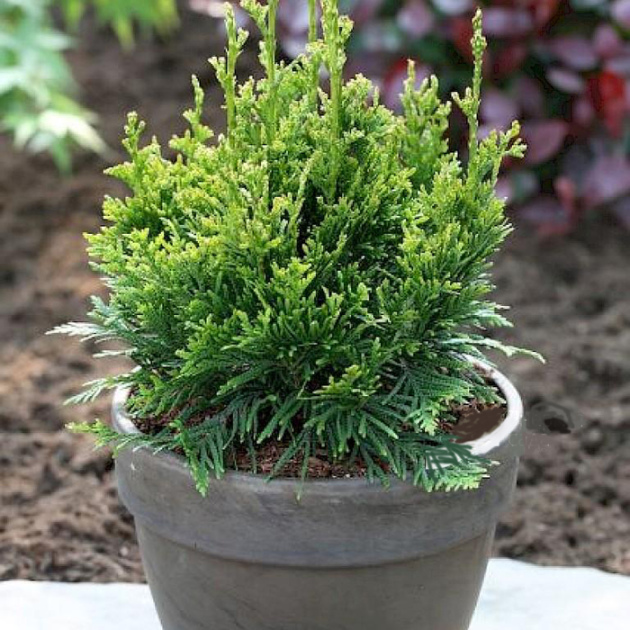
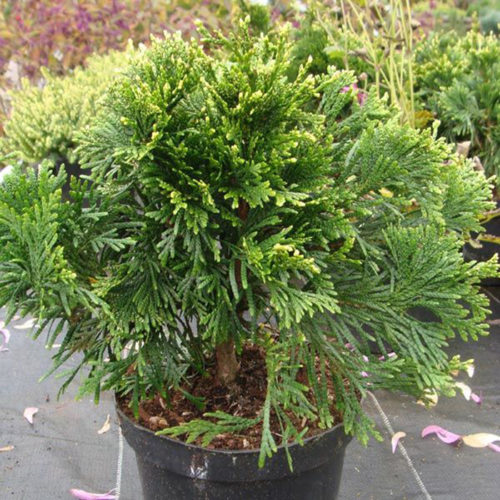
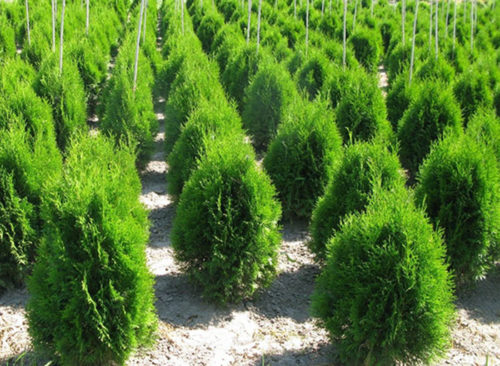


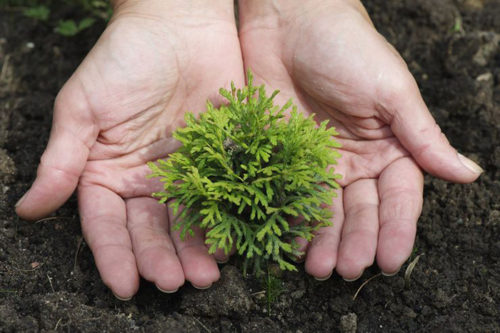
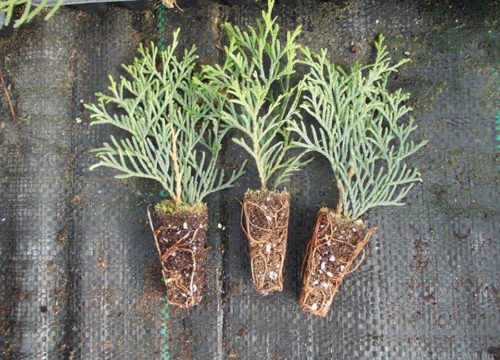

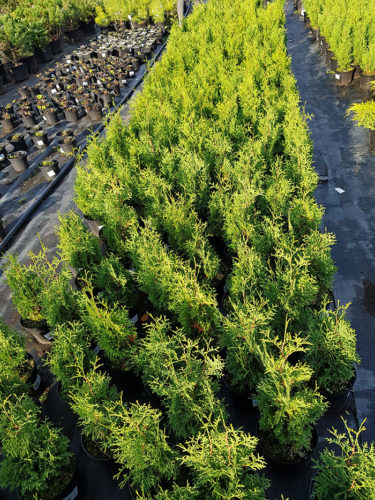


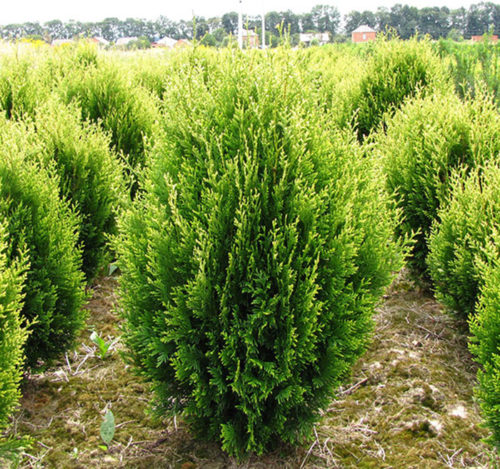
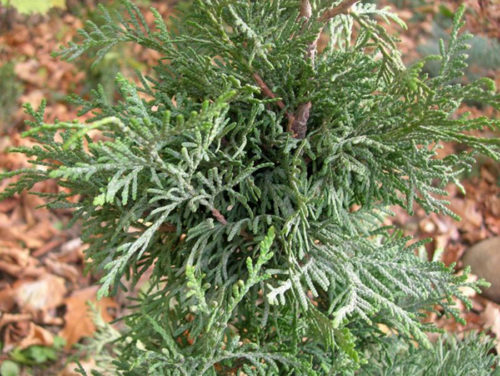
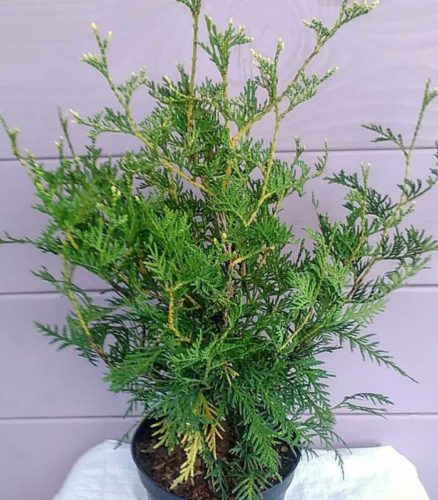
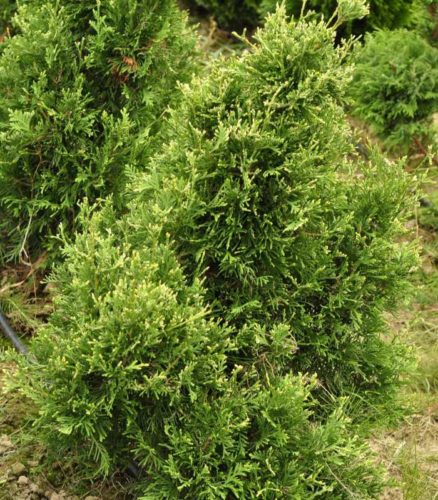













 Start a discussion ...
Start a discussion ...